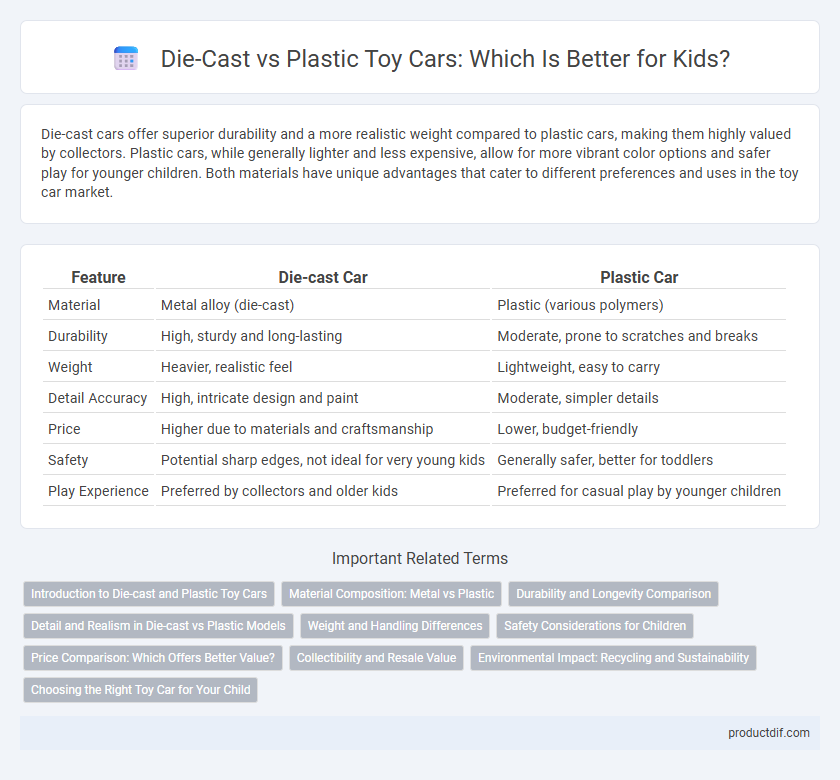Die-cast cars offer superior durability and a more realistic weight compared to plastic cars, making them highly valued by collectors. Plastic cars, while generally lighter and less expensive, allow for more vibrant color options and safer play for younger children. Both materials have unique advantages that cater to different preferences and uses in the toy car market.
Table of Comparison
| Feature | Die-cast Car | Plastic Car |
|---|---|---|
| Material | Metal alloy (die-cast) | Plastic (various polymers) |
| Durability | High, sturdy and long-lasting | Moderate, prone to scratches and breaks |
| Weight | Heavier, realistic feel | Lightweight, easy to carry |
| Detail Accuracy | High, intricate design and paint | Moderate, simpler details |
| Price | Higher due to materials and craftsmanship | Lower, budget-friendly |
| Safety | Potential sharp edges, not ideal for very young kids | Generally safer, better for toddlers |
| Play Experience | Preferred by collectors and older kids | Preferred for casual play by younger children |
Introduction to Die-cast and Plastic Toy Cars
Die-cast toy cars are made from metal alloys, primarily zinc, which provides durability and a realistic weight, making them highly collectible among enthusiasts. Plastic toy cars, crafted from various polymers, offer lightweight designs and vibrant colors, ideal for younger children due to their affordability and safety. Both types of toy cars serve distinct purposes in the market, with die-cast models appealing to collectors and plastic cars favored for everyday play.
Material Composition: Metal vs Plastic
Die-cast cars are primarily made of metal alloys such as zinc, aluminum, and magnesium, providing durability, weight, and a realistic feel that plastic cars lack. Plastic cars utilize materials like ABS, polystyrene, and PVC, making them lightweight, flexible, and often less expensive but less sturdy than metal counterparts. The choice of material composition directly influences the toy car's texture, longevity, and overall tactile experience for collectors and children alike.
Durability and Longevity Comparison
Die-cast cars outperform plastic cars in durability due to their metal construction, which resists wear, impact, and deformation over time. The longevity of die-cast models is significantly higher as they maintain structural integrity and aesthetic appeal despite frequent handling and play. Plastic cars, while lighter and often less expensive, tend to suffer from scratches, cracks, and color fading more rapidly under similar conditions.
Detail and Realism in Die-cast vs Plastic Models
Die-cast cars exhibit superior detail and realism due to their metal construction, allowing for finely crafted features such as accurate body lines, intricate grills, and authentic paint finishes. Plastic models often lack the same level of precision, with less defined details and paint that can appear less glossy or textured. Collectors and enthusiasts prefer die-cast cars for their lifelike appearance and durable, scale-accurate designs that closely mimic real vehicles.
Weight and Handling Differences
Die-cast cars are heavier due to their metal construction, providing a more realistic weight that enhances stability and smooth handling on tracks. Plastic cars are lighter, allowing for quicker acceleration but less stability during high-speed turns or rough play. Weight distribution in die-cast models contributes to better control, while plastic cars excel in agility and ease of manipulation.
Safety Considerations for Children
Die-cast cars offer enhanced durability and often meet stringent safety standards due to their metal construction, reducing the risk of breakage that can expose sharp edges. Plastic cars are generally lighter and less likely to cause injury upon impact, but they may contain small detachable parts posing choking hazards. Parents should verify certifications such as ASTM F963 or EN71 to ensure both die-cast and plastic cars comply with child safety regulations.
Price Comparison: Which Offers Better Value?
Die-cast cars typically offer better long-term value due to their durability and realistic details, often priced higher than plastic cars but justifying the cost for collectors and enthusiasts. Plastic cars, while more affordable, tend to have less durability and detail, making them ideal for casual play or budget-conscious buyers. When comparing price versus quality, die-cast models provide greater longevity and collectible appeal, whereas plastic options prioritize cost savings and accessibility.
Collectibility and Resale Value
Die-cast cars typically offer higher collectibility and resale value due to their durable metal construction, detailed craftsmanship, and limited production runs favored by collectors. Plastic cars, while more affordable and lightweight, generally hold less long-term value and appeal primarily to casual play rather than serious collecting. Market demand and brand reputation heavily influence both die-cast and plastic car resale prices, but die-cast models remain the preferred choice for investment in toy car collectibles.
Environmental Impact: Recycling and Sustainability
Die-cast cars, made primarily from metal alloys, are often more recyclable due to the high recovery rates of metals like zinc and steel, contributing to reduced environmental impact compared to plastic cars. Plastic cars, typically constructed from various polymers, pose recycling challenges due to mixed materials and lower recycling efficiency, leading to increased landfill waste and pollution. Choosing die-cast cars supports sustainability by leveraging materials that can be more effectively reclaimed and reused, minimizing long-term ecological footprint.
Choosing the Right Toy Car for Your Child
Die-cast cars offer superior durability and a realistic metal finish, making them ideal for collectors and older children who handle toys carefully. Plastic cars provide lightweight, vibrant designs with enhanced safety features suitable for younger children and rough play. Selecting the right toy car depends on the child's age, play style, and interest in detail versus durability.
Die-cast car vs Plastic car Infographic

 productdif.com
productdif.com